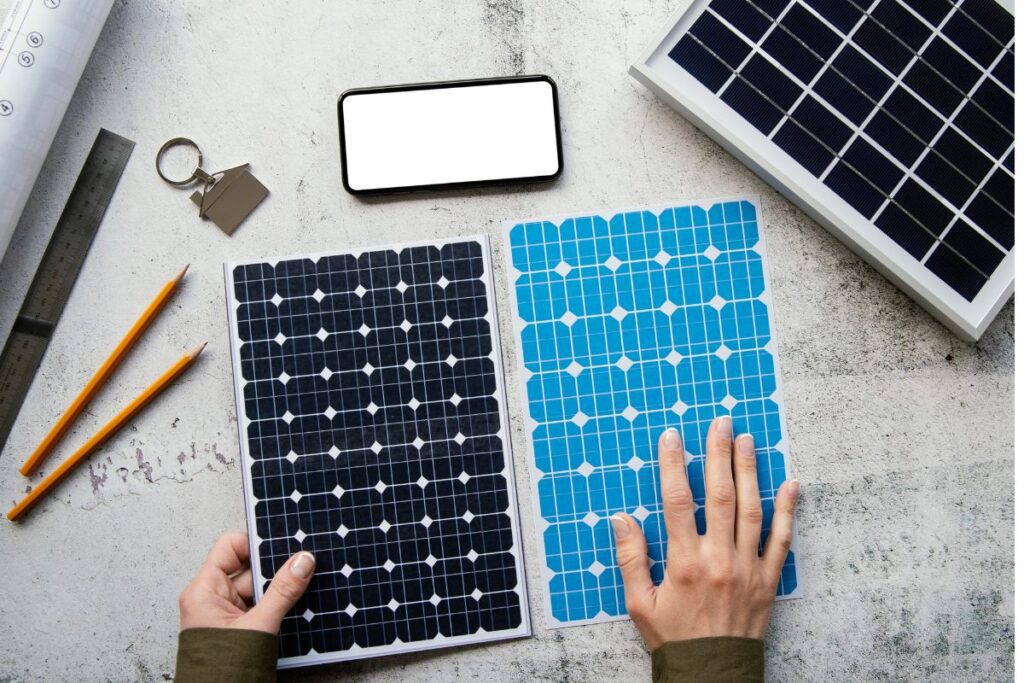Monocrystalline panels are more efficient, take up less space, and usually last a bit longer. They cost more up front. Polycrystalline panels are cheaper but produce less power in the same footprint. Both work, but if you’ve got limited roof space or care about long-term performance, monocrystalline is usually the better choice.
What’s the Real Difference?
- Monocrystalline panels are made from a single crystal of silicon. That makes them more efficient. Cleaner cut. Higher energy output per square foot.
- Polycrystalline panels are made from multiple silicon fragments melted together. They cost less, but they’re also less efficient. Learn more about the solar installation cost.
That’s it. That’s the core difference. Everything else you’ll hear is just detail built around that.

Efficiency Breakdown
If you have a smaller roof or if you want more output in less space, monocrystalline is usually the better choice. Most of the high-efficiency panels you see in modern installs are mono.
- Monocrystalline efficiency: 18–22%
- Polycrystalline efficiency: 15–17%
Those numbers don’t seem big on paper. But over 25 years, with Wisconsin’s snow load, cloudy days, and cold winters, it adds up.
Price Difference
Mono panels cost more. Usually 10-15% more per panel, sometimes more, depending on the brand and supply chain. But the total system price may not jump that much. Why? Because if you’re getting more output per panel, you might need fewer panels to hit your energy goals.
That means fewer mounting rails, fewer connections, and less installation labour. It evens out.
We always walk through the full cost-per-watt installed, not just sticker price.
What About Lifespan?
Both panel types last around 25 to 30 years, and both are backed by similar warranties. If the install is done right, they’ll both last decades. But, here’s where it gets tricky:
- Monocrystalline tends to degrade a little slower.
- Polycrystalline can drop off faster under heat or humidity.
In Wisconsin, with freeze-thaw cycles, that matters. But it’s not a dealbreaker.
What Most People Get Wrong
- They buy on price alone.
Bad idea. If your roof space is limited or shaded, low-efficiency panels will not make up for it just because they were cheaper. - They ignore what matters more, the installation.
I’ve seen mono systems installed wrong that underperform poly systems done right. A great panel with a sloppy inverter setup or bad racking won’t help you. - They assume all solar is the same.
It’s not. Efficiency, longevity, and maintenance all tie back to how well the system was planned. Panel type is part of that, but not the only part.
What We Recommend at Lehmann Electrical
We install both. But we usually recommend monocrystalline panels unless there’s a specific reason to go with poly.
Why?
- You get more energy per square foot
- Better performance in low-light (important here in winter)
- Less degradation over time
- Cleaner look, aesthetics matter to some folks
We’ve installed systems on ranch homes, cabins, and commercial shops across Wisconsin. We look at your actual power needs, how much roof you’ve got, what direction it faces, and how much snow loads it’s going to see. Then we figure out what works.
Sometimes poly panels make sense, like if you’ve got tons of roof space, you’re trying to hit a certain price, or the system is off-grid and not space-sensitive. But for most homes trying to reduce a utility bill or cover 100% of usage, mono’s worth the difference.
Monocrystalline vs Polycrystalline: Key Points
| Feature | Monocrystalline | Polycrystalline |
| Efficiency | 18–22% | 15–17% |
| Appearance | Uniform black | Blue, fragmented |
| Space efficiency | Higher | Lower |
| Cost | Higher | Lower |
| Lifespan | 25–30 years | 25–30 years (may degrade faster) |
| Best for | Small roofs, max output | Large roofs, budget-focused |
Final Thoughts
Lehmann Electrical sizes the system right, installs it right, and makes sure you know what you’re getting.
If you’re thinking about solar but don’t know where to start, just reach out to us. Call us at +1 414-207-0109 or visit our office. Get direction.
Q: Can I mix mono and poly panels in one solar system?
A: Technically, yes, but it’s not advised. Different electrical characteristics, like voltage and current, can cause performance issues if mismatched .
Q: Do polycrystalline panels handle heat differently than monocrystalline?
A: They do. Polycrystalline panels tend to have a higher temperature coefficient, so they lose more efficiency as temperature rises. Monocrystalline panels perform better in both hot and cold conditions .
